
TRIBUTES TO WOMEN IN AVIATION

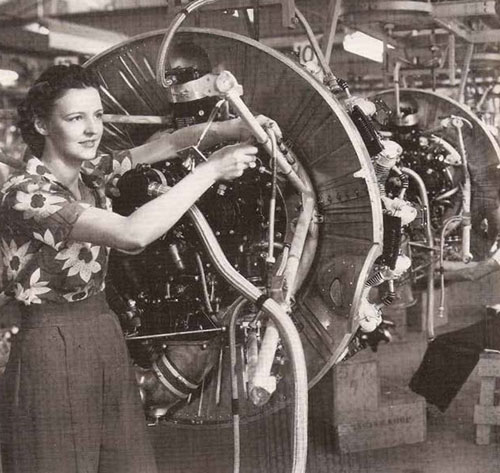
“Although pilots are the stars of our show, women were active in every field of aviation. All of us, men and women alike, need their stories and their inspiration. Remembrance is a sign of honor.”
Kirk House, “Flying High, Pioneer Women in American Aviation”
March is recognized in the U.S. as “women in aviation” month, which caused me to focus my search for commemorative aviation sites on those which honor female pilots and astronauts. There have been many women who achieved recognition for their pioneer flying but many more who remain obscure and unknown. Here are a few of the most prominent early American ladies with wings.
Bessie Coleman (1892-1926) was the first black woman in the U.S. to hold a pilot’s license. Banned from all-white and all-male flight schools, she took flying lessons in France and Germany between 1920 and 1921. Returning to the U.S., she made exhibition flights in a surplus military biplane. Known as “Queen Bess,” she made daring, skillful flights until the accident that killed both her and her mechanic in 1926, at Jacksonville, FL. Tributes to Coleman include a bronze plaque at the entrance to the Paxon School for Advanced Studies (which is next to the site of the Jacksonville airfield), a road at Chicago’s O’Hare International Airport and another in Waxachachie, TX.
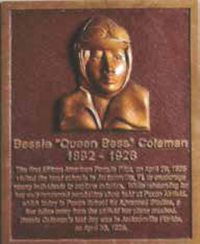
Katherine Stinson (1891-1977) was the fourth woman in the U.S. to earn her pilot’s license in 1912. In 1915, at San Antonio, TX, Stinson started a flight school with her mother, sister and two brothers. Stinson made spectacular exhibition flights and she is recognized as the first woman to fly at night, make a flying “loop,” and carry U.S. air mail. She gained adoration in the U.S., Japan and Canada where she flew on tour. Stinson’s school closed in 1917 and she did not fly again. She volunteered to drive an ambulance in Europe during WWI and later had a successful career as an architect in New Mexico. Tributes to Stinson include San Antonio’s Stinson Municipal Airport (KSSF), which is named for her entire family, as well as the Katherine Stinson Middle School (also in San Antonio).
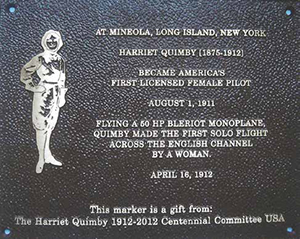
Amelia Earhart (1897-1937) might be the most honored aviatrix in the world. I have seen dozens of tributes to her, including a bronze statue at the Amelia M. Earhart Branch of the North Hollywood Public Library in California, and in her home town of Atchison, KS. Atchison has two Earhart statues and a bridge and an airport in her name. Several grammar schools and many bronze plaques exist in almost every state she visited, including one at Diamond Head, HI. Earhart’s name graces dozens of streets, a dam in Massachusetts, a regional park in Miami and at least two forests.
Louise Thaden (1905-1979) worked for Walter Beech at the Travel Air Corporation in Kansas when she earned her pilot’s license in 1927. Thaden was the first person flying a light plane to simultaneously hold altitude, endurance and speed records in 1929. Thaden won the 1929 Women’s Air Derby flying a Travel Air. That same year, she and Earhart founded the International Association of Women Pilots (known as the Ninety-Nines). Women were excluded from the Bendix Air Race until 1936, when Thaden entered and won. Tributes include a library bearing her name at the National Staggerwing Museum in Tennessee and Louise M. Thaden Field (KVBT) at the airport in Bentonville, AR.
Jerrie Mock (1925- ) was the first woman to solo around the world in 1964. She flew a Cessna 180, the “Spirit of Columbus,” for 29 days and more than 22,000 miles. Mock created or broke several speed and distance records between 1964 and 1969, as well as her numerous firsts while circumnavigating the globe. Tributes to Mock include a street for her at Rickenbacher International Airport in Ohio, and a full-scale statue unveiled in 2013 at the courtyard of The Works Ohio Center of History, Art and Technology in Newark, OH.
Women in the Military and Space
The Women Airforce Service Pilots (WASPs) of WWII, were not eligible for military benefits until 1977. Their contributions, including the loss of 38 while in service, have since been widely recognized in books and documentary films as well as their receipt of the Distinguished Service Medal in 2010. Tributes to the WASPs include The University of Wisconsin’s courtyard statue and a bronze list of WASP names. In 2011, 12 WASPs from Orange County, CA, were honored with a plaque, a monument and pepper trees planted on the campus of Brea Olinda High School.
Jacqueline Cochran (1906-1980), a famous pilot for her speed, distance and altitude records, was the first woman to fly a bomber across the Atlantic Ocean in 1941, while ferrying aircraft to Britain. When the U.S. entered WWII, Cochran organized the WASPs who trained at Avenger Field in Sweetwater, TX. Cochran might have achieved more record-breaking flights than any male or female in U.S. history, including the first woman to break the sound barrier (1953), the first woman to land and take off from an aircraft carrier, and the first woman to fly at Mach 2. Tributes to Cochran include the Jacqueline Cochran Regional Airport (KTRM) at Thermal, CA, where there is also a monument bearing a sculpture of the aviatrix.
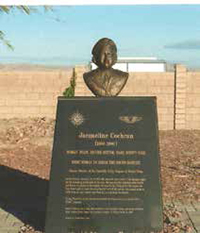
The “Mercury 13” were the first women who (almost) participated in the U.S. astronaut program. In the 1960s, Cochran gained testing for the first women in NASA’s space program. Thirteen qualified, but Congress ruled that women were not fit to be astronauts. Modern history books and a documentary for television and women in aviation conferences have since recognized their contributions, but to date, no tribute in the form of a statue or plaque has been made for the Mercury 13.
Sally Ride (1951-2012) was America’s first woman in space and has elementary schools named for her in Woodlands, TX, and Germantown, MD. In 2012, NASA named the landing site of a lunar probe in her honor.
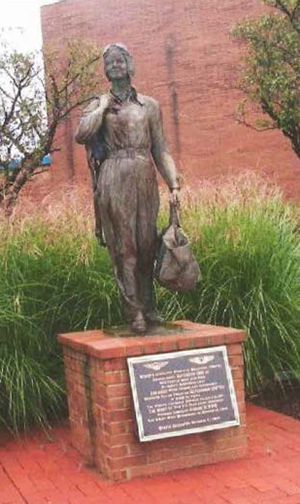
There are statues for deceased astronauts Jack Swigert, James Reilly, Mike Anderson and Willie McCool. Christa McAuliffe, Judith Resnick, Laurel B. Clark and Kaplana Chawla died in space shuttle accidents. Tributes to our women in space include a wide array of buildings, streets, asteroids, lunar sites, fountains, parks, a hill on Mars and craters on Venus. However, for a statue of a North American female astronaut, you would have to visit Ontario, Canada, where that country’s first female in space, Roberta Bondar, graces a park in Sault Ste. Marie.
Perhaps the success of the 2013 film “Gravity,” starring Sandra Bullock, will inspire a monument or statue to honor our female astronauts. As aviation historian Kirk House wrote, “Remembrance is a sign of honor.” When Jerrie Mock learned of the statue in her honor, she said that she hoped her sculpture would cause a child to learn of her flight and be inspired. Said Mock, “I’d tell them, don’t listen to people who say women can’t do things. That’s nonsense.”
 Giacinta Bradley Koontz is an aviation historian, magazine columnist and author who has received the DAR History Medal and Honorable Mention from the New York Book Festival. She has appeared on the History Channel and in PBS documentaries. For more information, visit www.GiaBKoontz.com.
Giacinta Bradley Koontz is an aviation historian, magazine columnist and author who has received the DAR History Medal and Honorable Mention from the New York Book Festival. She has appeared on the History Channel and in PBS documentaries. For more information, visit www.GiaBKoontz.com.
